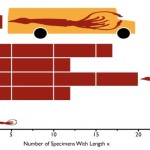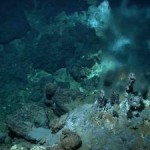


Here’s a quiz for you kids. Which of the habitats above possesses the most microbes? A. Fresh Volcanic Basalt on the seafloor, B. Sargasso Sea Water, or C. Farm Soil
A recent study by led by Santelli in Nature provides an answer that may surprise you. It turns out at A and C are the right answer.
We demonstrate that prokaryotic cell abundances on seafloor-exposed basalts are 3-4 orders of magnitude greater than in overlying deep sea water. Phylogenetic analyses of basaltic lavas from the East Pacific Rise (96 N) and around Hawaii reveal that the basalt-hosted biosphere harbours high bacterial community richness and that community membership is shared between these sites.
Now here is the really freaky part. What supports these bacteria? The authors hypothesized and lab evidence supports that chemical reactions of the basalt provide the energy needed to fuel bacterial growth. Volcanic glass is high reactive containing iron, sulphur, and maganese. When oxygen and nitrate in the surrounding water oxidize these elements, chemolithoautotrophic microogranisms could potentially use the free energy associated with these reactions.
Take awhile for that to sink in…because what that means is that our understanding of carbon cycling and deep-sea systems is missing an entire food source and web.
Santelli, C.M., Orcutt, B.N., Banning, E., Bach, W., Moyer, C.L., Sogin, M.L., Staudigel, H., Edwards, K.J. (2008). Abundance and diversity of microbial life in ocean crust. Nature, 453(7195), 653-656. DOI: 10.1038/nature06899





